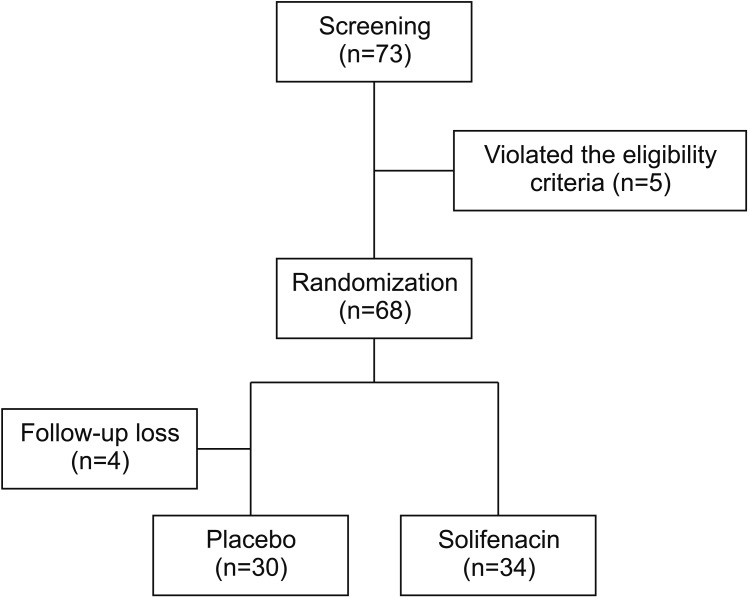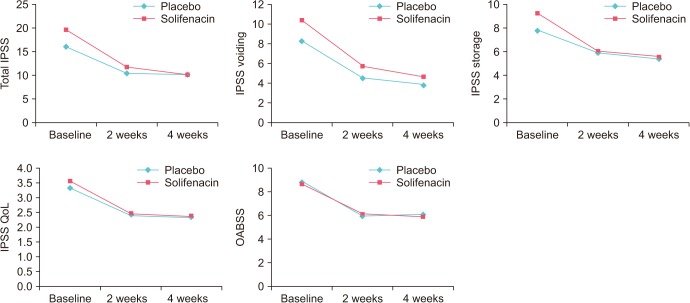Investig Clin Urol.
2019 Nov;60(6):480-487. 10.4111/icu.2019.60.6.480.
Influence of solifenacin on the improvement of storage symptoms in the early period after photoselective vaporization of the prostate
- Affiliations
-
- 1Department of Urology, Yonsei University Wonju College of Medicine, Wonju, Korea.
- 2Department of Urology, The Catholic University of Korea, Seoul St. Mary's Hospital, College of Medicine, The Catholic University of Korea, Seoul, Korea. ksw1227@catholic.ac.kr
- 3Catholic Integrative Medicine Research Institute, The Catholic University of Korea, Seoul, Korea.
- KMID: 2461060
- DOI: http://doi.org/10.4111/icu.2019.60.6.480
Abstract
- PURPOSE
We studied the effect of solifenacin on reducing storage symptoms after photoselective vaporization of the prostate (PVP).
MATERIALS AND METHODS
This study included patients with persistent storage symptoms of urgency and frequency in a 3-day voiding diary, International Prostate Symptom Score (IPSS) storage subscore (IPSS-s) ≥5, overactive bladder symptom score (OABSS) ≥5, and OABSS for question 3 ≥4 at 5 days after urethral catheter removal. The patients were randomly assigned to receive once-daily solifenacin 5 mg or placebo for 4 weeks. Evaluation of the 3-day voiding diary, IPSS, and OABSS was performed at 2 and 4 weeks after treatment.
RESULTS
At 2 and 4 weeks after treatment, the urgency and frequency in the 3-day voiding diary, IPSS, IPSS-s, and OABSS were decreased in the solifenacin group. Although the OABSS of the solifenacin group was not significantly different from that of the placebo group, the OABSS of the placebo group increased at 4 weeks compared with that at 2 weeks after treatment. The Benefit, Satisfaction, and Willingness to continue questionnaire showed no significant difference in patient satisfaction between the groups. Although the solifenacin group showed increased post-void residual volume compared with the placebo group, there was no statistically significant difference.
CONCLUSIONS
Storage symptoms measured using OABSS tended to decrease after medication with solifenacin in the early period after PVP. Therefore, we suggest that anticholinergics have a potential role in improving storage symptoms after PVP.
Keyword
MeSH Terms
-
Cholinergic Antagonists
Humans
Laser Therapy
Lower Urinary Tract Symptoms
Muscarinic Antagonists
Patient Satisfaction
Postoperative Period
Prostate*
Prostatic Hyperplasia
Residual Volume
Solifenacin Succinate*
Urinary Bladder, Overactive
Urinary Catheters
Volatilization*
Cholinergic Antagonists
Muscarinic Antagonists
Solifenacin Succinate
Figure
Reference
-
1. Yeo JK, Choi H, Bae JH, Kim JH, Yang SO, Oh CY, et al. Korean clinical practice guideline for benign prostatic hyperplasia. Investig Clin Urol. 2016; 57:30–44.2. Mandeville J, Mourtzinos A. Surgical management of male voiding dysfunction. Surg Clin North Am. 2016; 96:491–501. PMID: 27261790.
Article3. Nitti VW, Kim Y, Combs AJ. Voiding dysfunction following transurethral resection of the prostate: symptoms and urodynamic findings. J Urol. 1997; 157:600–603. PMID: 8996367.
Article4. Abrams PH, Farrar DJ, Turner-Warwick RT, Whiteside CG, Feneley RC. The results of prostatectomy: a symptomatic and urodynamic analysis of 152 patients. J Urol. 1979; 121:640–642. PMID: 86617.
Article5. Gormley EA, Griffiths DJ, McCracken PN, Harrison GM, McPhee MS. Effect of transurethral resection of the prostate on detrusor instability and urge incontinence in elderly males. Neurourol Urodyn. 1993; 12:445–453. PMID: 7504554.
Article6. Hyman MJ, Groutz A, Blaivas JG. Detrusor instability in men: correlation of lower urinary tract symptoms with urodynamic findings. J Urol. 2001; 166:550–552. PMID: 11458066.
Article7. Housami F, Abrams P. Persistent detrusor overactivity after transurethral resection of the prostate. Curr Urol Rep. 2008; 9:284–290. PMID: 18765127.
Article8. Kageyama S, Watanabe T, Kurita Y, Ushiyama T, Suzuki K, Fujita K. Can persisting detrusor hyperreflexia be predicted after transurethral prostatectomy for benign prostatic hypertrophy? Neurourol Urodyn. 2000; 19:233–240. PMID: 10797580.
Article9. Zhao YR, Liu WZ, Guralnick M, Niu WJ, Wang Y, Sun G, et al. Predictors of short-term overactive bladder symptom improvement after transurethral resection of prostate in men with benign prostatic obstruction. Int J Urol. 2014; 21:1035–1040. PMID: 24825248.
Article10. YI Q, Gong M, Hu W, Tian B, Zhu F, Wang T, et al. Efficacy of solifenacin in the treatment of overactive bladder syndrome after transurethral resection of the prostate. Chin J Urol. 2011; 32:415–418.11. Tanaka Y, Masumori N, Itoh N, Furuya S, Ogura H, Tsukamoto T. Is the short-term outcome of transurethral resection of the prostate affected by preoperative degree of bladder outlet obstruction, status of detrusor contractility or detrusor overactivity? Int J Urol. 2006; 13:1398–1404. PMID: 17083391.
Article12. Antunes AA, Iscaife A, Reis ST, Albertini A, Nunes MA, Lucon AM, et al. Can we predict which patients will experience resolution of detrusor overactivity after transurethral resection of the prostate? J Urol. 2015; 193:2028–2032. PMID: 25583645.
Article13. Jeong SJ, Lee SC, Jeong CW, Hong SK, Byun SS, Lee SE. Clinical and urodynamic differences among women with overactive bladder according to the presence of detrusor overactivity. Int Urogynecol J. 2013; 24:255–261. PMID: 22588142.
Article14. Giarenis I, Mastoroudes H, Srikrishna S, Robinson D, Cardozo L. Is there a difference between women with or without detrusor overactivity complaining of symptoms of overactive bladder? BJU Int. 2013; 112:501–507. PMID: 23452071.
Article15. Hamann MF, Naumann CM, Seif C, van der Horst C, Jünemann KP, Braun PM. Functional outcome following photoselective vaporisation of the prostate (PVP): urodynamic findings within 12 months follow-up. Eur Urol. 2008; 54:902–907. PMID: 18502565.
Article16. Matoka DJ, Averch TD. Predictability of irritative voiding symptoms following photoselective laser vaporization of the prostate. Can J Urol. 2007; 14:3710–3714. PMID: 17949529.17. Al-Ansari A, Younes N, Sampige VP, Al-Rumaihi K, Ghafouri A, Gul T, et al. GreenLight HPS 120-W laser vaporization versus transurethral resection of the prostate for treatment of benign prostatic hyperplasia: a randomized clinical trial with midterm follow-up. Eur Urol. 2010; 58:349–355. PMID: 20605316.
Article18. Pereira-Correia JA, de Moraes Sousa KD, Santos JB, de Morais Perpétuo D, Lopes-da-Silva LF, Krambeck RL, et al. GreenLight HPS™ 120-W laser vaporization vs transurethral resection of the prostate (<60 mL): a 2-year randomized double-blind prospective urodynamic investigation. BJU Int. 2012; 110:1184–1189. PMID: 22257240.
- Full Text Links
- Actions
-
Cited
- CITED
-
- Close
- Share
- Similar articles
-
- Letter to the editor: Influence of solifenacin on the improvement of storage symptoms in the early period after photoselective vaporization of the prostate
- Factors Affecting the Improvement of the Initial Peak Urinary Flow Rate after Transurethral Resection of the Prostate or Photoselective Vaporization of the Prostate for Treating Benign Prostatic Hyperplasia
- Effect of Photoselective Vaporization Prostatectomy on Lower Urinary Tract Symptoms in Benign Prostatic Hyperplasia With or Without Intravesical Prostatic Protrusion
- Changes in Nocturia after Photoselective Vaporization of the Prostate for Patients with Benign Prostatic Hyperplasia
- Impact of Lower Urinary Tract Symptoms/Benign Prostatic Hyperplasia Treatment with Tamsulosin and Solifenacin Combination Therapy on Erectile Function



